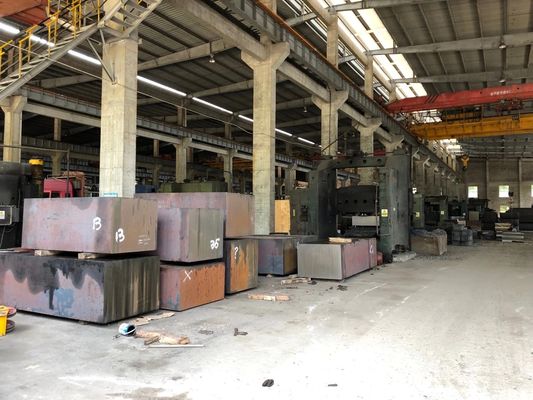H13 Steel Block 300mm thickness For Hot Extrusion Dies, Precision Forging Dies Production
H13 die steel is used to manufacture forging dies, hot extrusion dies, precision forging dies with large impact loads, and die casting dies for aluminum, copper and their alloys. H13 Tool Steel is a versatile chromium-molybdenum hot work steel that is widely used in hot work and cold work tooling applications. The hot hardness (hot strength) of H13 resists thermal fatigue cracking which occurs as a result of cyclic heating and cooling cycles in hot work tooling applications. Because of its excellent combination of high toughness and resistance to thermal fatigue cracking (also known as heat checking) H13 is used for more hot work tooling applications than any other tool steel.
Because of its high toughness and very good stability in heat treatment, H13 is also used in a variety of cold work tooling applications. In these applications, H13 provides better hardenability (through hardening in large section thicknesses) and better wear resistance than common alloy steels such as 4140.
Also available as Electro-Slag-Remelted (ESR) and Vacuum-Arc-Remelted (VAR) products as well. The remelting processes provide improved chemical homogeneity, refinement of carbide size, and the associated improvements in mechanical properties and fatigue properties.
APPLICATIONS: Inserts, cores, and cavities for die casting dies, die casting shot sleeves, hot forging dies, extrusion dies, and plastic mold cavities and components that require high toughness and excellent polishability.
2. Common H13/1.2344/SKD61 Tool Steel Related Specifications
| Country |
USA |
German |
Japan |
| Standard |
ASTM A681 |
DIN EN ISO 4957 |
JIS G4404 |
| Grades |
H13 |
1.2344/X40CrMoV5-1 |
SKD61 |
3. H13/1.2344/SKD61Tool Steel Chemical Composition
| ASTM A681 |
C |
Mn |
P |
S |
Si |
Cr |
V |
Mo |
| H13 |
0.32 |
0.45 |
0.2 |
0.6 |
0.03 |
0.03 |
0.8 |
1.25 |
4.75 |
5.5 |
0.8 |
1.2 |
1.1 |
1.75 |
| DIN ISO 4957 |
C |
Mn |
P |
S |
Si |
Cr |
V |
Mo |
| 1.2344 /X40CrMoV5-1 |
0.35 |
0.42 |
0.25 |
0.5 |
0.03 |
0.02 |
0.8 |
1.2 |
4.8 |
5.5 |
0.85 |
1.15 |
1.1 |
1.5 |
| JIS G4404 |
C |
Mn |
P |
S |
Si |
Cr |
V |
Mo |
| SKD61 |
0.35 |
0.42 |
0.25 |
0.5 |
0.03 |
0.02 |
0.8 |
1.2 |
4.8 |
5.5 |
0.8 |
1.15 |
1.0 |
1.5 |


Forging
Heating AISI H13 in two steps, first to a temperature of 750 °C - 800 °C for an appropriate time, then to a temperature of 1050 °C - 1100 °C for a sufficient time to allow the steel to be heated thoroughly, and must be reheated when the temperature falls below 950 °C.
Annealing
Annealing is considered to be a suitable treatment for processing. The temperature is heated to 840 °C - 860 °C, held for a suitable time so that the steel is heated thoroughly, and then cooled back to the furnace. The annealed black surface has a hardness of ≤ 255 HB.
Stress relief
Stress relieving is recommended after machining and before hardening to reduce the possibility of deformation. H13 should be heated to 600-650°C and held for 2 hours. Cool slowly in the furnace.
Quenching
Preheating temperature: 600-850°C, usually in two preheating steps.
Austenitizing temperature. 1020-1050°C,normally 1020-1030°C
Tempering
Tempering should be done immediately after quenching. Heat slowly and evenly to tempering temperature and soak for not less than 2 hours (1 hour for every 25 mm of total thickness). The usual tempering range is 530-650°C, depending on the hardness required and the operating temperature of the tool. Two tempering sessions are strongly recommended and H13 should be cooled to room temperature between tempering sessions. Tempering in the 425-550°C range is not recommended due to the reduced toughness properties.
Applications
H13 hot work tool steel has excellent properties and is used in a wide range of hot work and cold work applications.
Typical applications include die casting dies for aluminum, magnesium and zinc, extrusion dies for aluminum and brass, liners, mandrels, pressure pads, followers, bolts, die shells, die holders and adapter rings for copper and brass extrusion. H13 is used to produce hot stamping and press forging dies, split hot heading dies, clamping dies, hot stamping, piercing and trimming tools. Other applications include plastic molds, shear blades for hot work and hot press welding dies.

 Your message must be between 20-3,000 characters!
Your message must be between 20-3,000 characters! Please check your E-mail!
Please check your E-mail!  Your message must be between 20-3,000 characters!
Your message must be between 20-3,000 characters! Please check your E-mail!
Please check your E-mail! 





